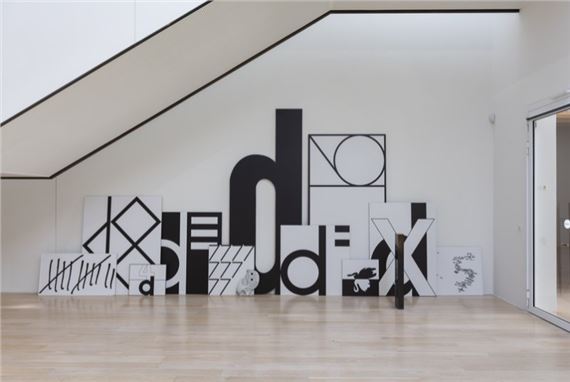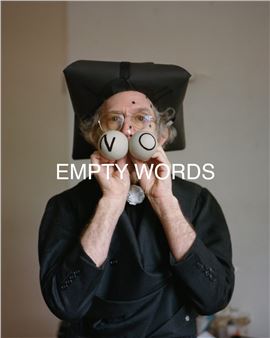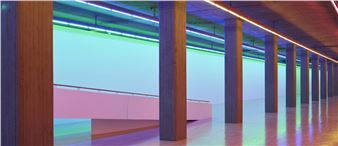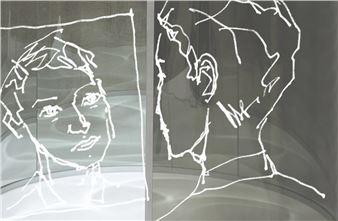The Remains of 100 Days…
In 1955, the first documenta took place in Kassel. In 2022, sixty-seven years later, the fifteenth edition of the exhibition is now being presented. For a long time, the 100-day exhibition was regarded as a reliable status report on the art of its respective present and had a lasting influence on the programs and collections of the art museums of the Federal Republic of Germany. At the same time, it has always been an important motor of institutional critique: What was discussed, collected, and exhibited was, and still is, often initiated by the documenta. This influence is also clearly documented in the exhibition history of the Lenbachhaus. Our last project for example, "Group Dynamics – Collectives of the Modernist Period," would have been inconceivable without Documenta11, curated by Okwui Enwezor.
Today, the history of the documenta and its founding myths are viewed critically. In recent years, especially the continuities from National Socialism to the young Federal Republic have been the subject of research, as well as of the comprehensive exhibition "documenta. Politics and Art" at the Deutsches Historisches Museum in Berlin. The documenta has also since been stripped of its status as the "most important exhibition of contemporary art in the Western world." Nevertheless, with all its contradictions, it remains to this day one of the most interesting exhibition projects, characterized by changing curatorial teams. Thus, despite all its crises, the documenta has established itself as an institution and has continually updated itself by defining new claims, tasks, and strategies.

Recommended for you
In 1955, the first documenta took place in Kassel. In 2022, sixty-seven years later, the fifteenth edition of the exhibition is now being presented. For a long time, the 100-day exhibition was regarded as a reliable status report on the art of its respective present and had a lasting influence on the programs and collections of the art museums of the Federal Republic of Germany. At the same time, it has always been an important motor of institutional critique: What was discussed, collected, and exhibited was, and still is, often initiated by the documenta. This influence is also clearly documented in the exhibition history of the Lenbachhaus. Our last project for example, "Group Dynamics – Collectives of the Modernist Period," would have been inconceivable without Documenta11, curated by Okwui Enwezor.
Today, the history of the documenta and its founding myths are viewed critically. In recent years, especially the continuities from National Socialism to the young Federal Republic have been the subject of research, as well as of the comprehensive exhibition "documenta. Politics and Art" at the Deutsches Historisches Museum in Berlin. The documenta has also since been stripped of its status as the "most important exhibition of contemporary art in the Western world." Nevertheless, with all its contradictions, it remains to this day one of the most interesting exhibition projects, characterized by changing curatorial teams. Thus, despite all its crises, the documenta has established itself as an institution and has continually updated itself by defining new claims, tasks, and strategies.
Artists on show
- Alfred Kubin
- Andrea Büttner
- Asger Jorn
- Ceal Floyer
- Charlotte Posenenske
- Dan Graham
- Ellsworth Kelly
- Franz Erhard Walther
- Franz Marc
- Fritz Koenig
- Gabriele Münter
- Gerhard Richter
- Gerhard von Graevenitz
- Gianfranco Baruchello
- Gustav Metzger
- Gusztáv Hámos
- Hermann Nitsch
- Imi Knoebel
- Isa Genzken
- Jochen Gerz
- Joseph Beuys
- Katharina Sieverding
- Marcel Odenbach
- Marina Abramović
- Mirjam Cahn
- Nam June Paik
- Nevin Aladag
- Olaf Nicolai
- Öyvind Fahlström
- Robert Delaunay
- Rupprecht Geiger
- Stansfield / Hooykaas
- Tejal Shah
- Telewissen
- Thomas Bayrle
- Ulay
- Ulrike Rosenbach
- Valie Export
- Walker Evans
- Wassily Kandinsky
Related articles
In 1955, the first documenta took place in Kassel. In 2022, 67 years later, the 15th edition of the exhibition is now being presented.

 ARTISTS
ARTISTS
















